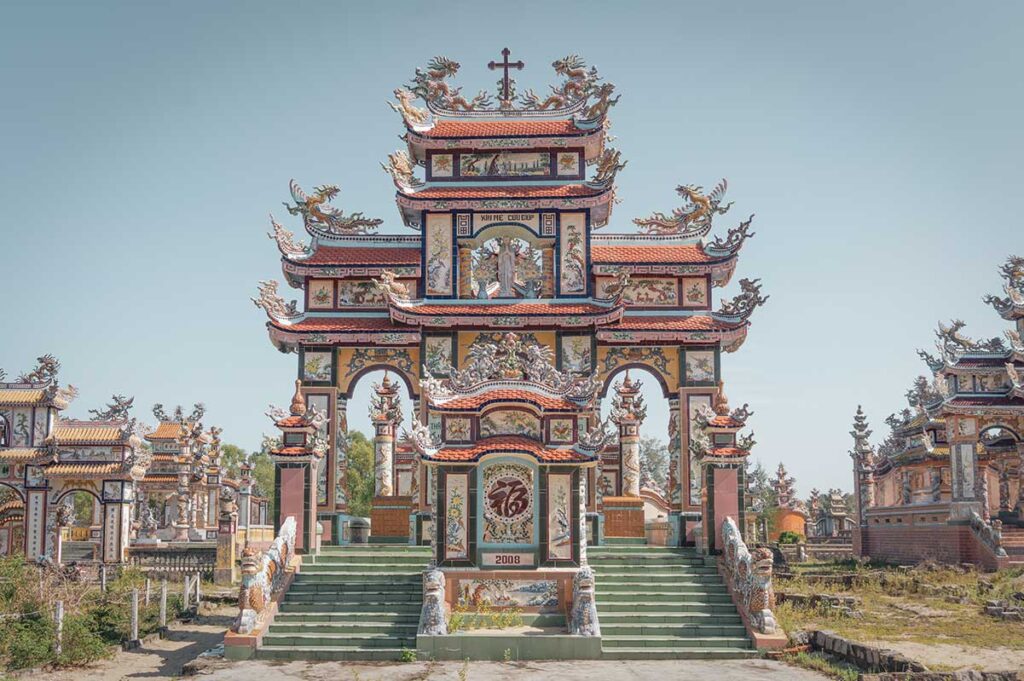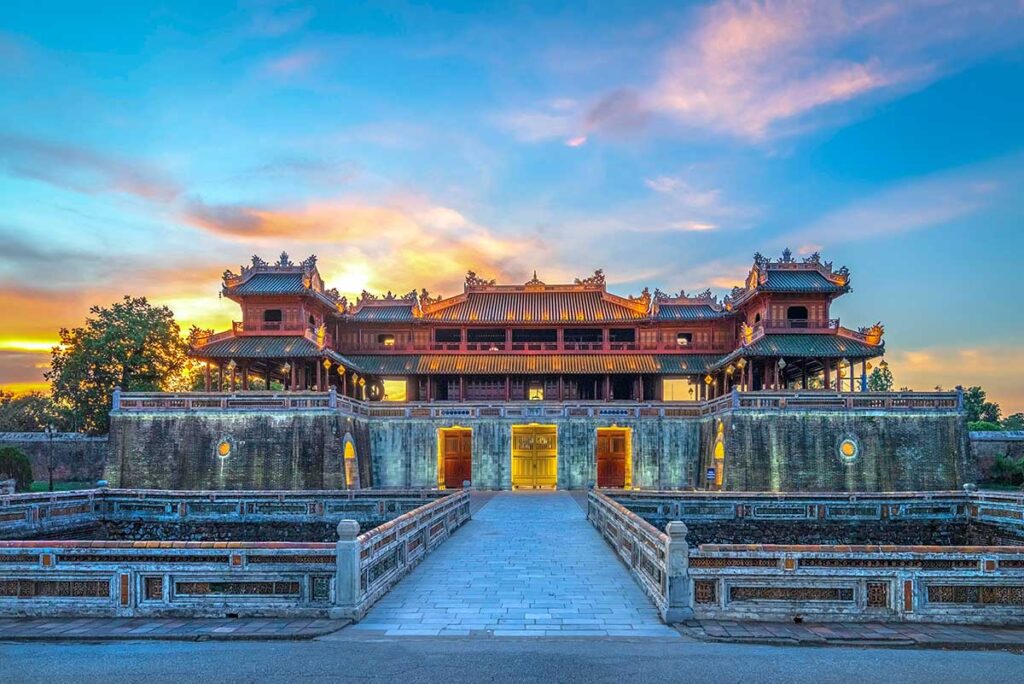What is An Bang Cemetery?
An Bang Cemetery is a vast burial ground located in a coastal village east of Hue. It’s often called Vietnam’s City of Ghosts — not because it feels haunted, but because it looks like a silent, colorful city built for the dead. From afar, the skyline of towering tombs and bright mosaics rises out of the white dunes like a mirage. Behind the cemetery lies An Bang Beach, a quiet local stretch of sand used mainly by fishermen and their families — not to be confused with the well-known An Bang Beach near Hoi An.
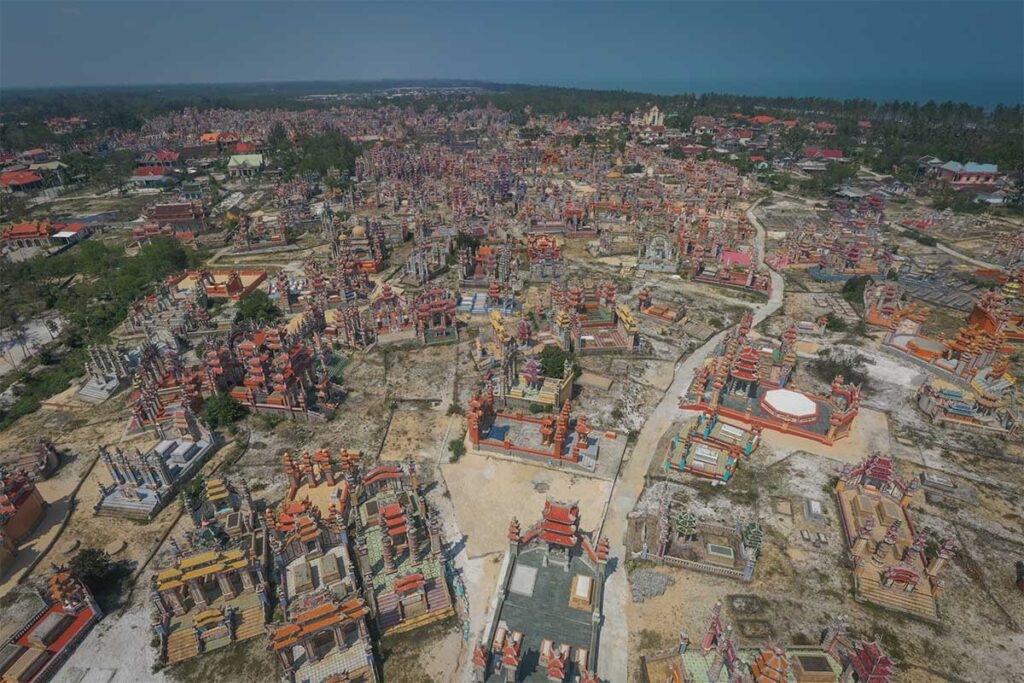
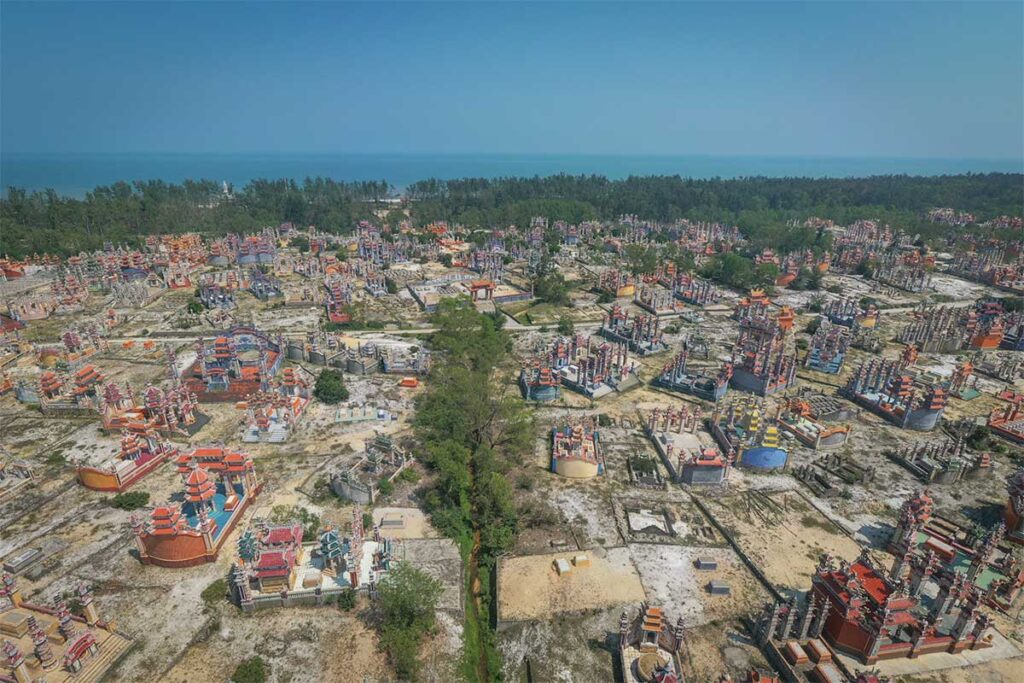
What makes this cemetery so remarkable is its sheer scale and artistry. Thousands of tombs, some standing two or three stories tall, cover several kilometers of sandy ground. The designs are incredibly diverse, mixing Buddhist, Taoist, Catholic, Chinese, and even Western influences. Many mausoleums resemble miniature temples or royal palaces, complete with arches, dragons, and vibrant ceramic mosaics that shimmer under the sun.


Most of the people buried here come from families with relatives who emigrated overseas after the Vietnam War. These families send money home, and much of it has been used to build increasingly elaborate tombs as acts of filial devotion. In Vietnamese culture, creating a grand resting place for one’s ancestors is seen as a sign of respect and a way to bring good fortune to future generations. Some families even build their own tombs while still alive to prepare for the afterlife.

Costs vary widely — simple tombs might cost a few thousand dollars, while the most extravagant ones can reach or exceed USD 50,000, sometimes more. The result is a landscape that feels both personal and monumental, where love, pride, and artistry are expressed in stone and color.
Why it’s also called the “City of Ghosts”
The nickname “City of Ghosts” naturally comes from the fact that it’s a cemetery, yet in Vietnam, the word “ghost” carries a more complex meaning than in the West. Many Vietnamese believe that the spirits of their ancestors continue to exist and can influence the living, which is why ancestor worship remains one of the country’s most important traditions.
Families visit graves to offer incense, food, and prayers, ensuring their ancestors are honored and cared for in the afterlife. In An Bang, this belief is expressed on a grand scale — some people even build their own tombs before they die, preparing their next “home.” Within the cemetery, you’ll see Buddhist stupas standing beside Catholic crosses and Taoist symbols, all coexisting peacefully. Despite its dramatic nickname, the City of Ghosts isn’t a spooky place at all; it’s a celebration of life, memory, and family devotion, beautifully expressed in stone and color.
Location and Getting there
Where is An Bang Cemetery?
An Bang Cemetery lies in a small coastal area east of Hue, within An Bang village, Vinh An commune of Phu Vang District. The setting is striking — between the Tam Giang Lagoon system and the open sea, where the land is mostly white sand dotted with fishing villages and low pine trees. The cemetery itself blends into the village; tombs often stand just behind family homes or along the narrow lanes that weave toward the beach. There’s little signage, and the roads become sandy as you approach, which adds to its remote, almost dreamlike atmosphere.
How to get there
Reaching An Bang Cemetery isn’t difficult, but it does require a bit of planning. The final stretch winds through quiet rural roads, so motorbike, taxi, or private car are the best options.
Driving motorbike:
This is the most flexible way to visit. Search for “Nghia trang An Bang” on Google Maps and follow the coastal route. The ride takes about an hour from Hue and passes through scenic countryside and small fishing villages. Expect sandy, uneven patches near the end, so it’s best for confident riders comfortable with loose terrain.
Taxi:
A convenient choice if you’re staying in Hue and don’t want to drive yourself. Taxis can reach the village but may struggle with the narrow lanes inside. Agree on a waiting time and return fare in advance, and share the exact map pin with your driver to avoid confusion.
Private car with driver:
The easiest and most comfortable option, especially if you want to combine the visit with other coastal stops like Tam Giang Lagoon or local beaches. A driver familiar with the area will know how to navigate the small roads and wait while you explore. It’s also a great choice for photographers aiming to visit during sunrise or late afternoon when the light brings out the colors of the tombs.
How to visit An Bang Cemetery: Expectations & Etiquette
An Bang Cemetery is a living cemetery, not a curated attraction. You’ll be walking through narrow sandy lanes surrounded by family tombs that locals still visit and maintain. Expect a peaceful but visually intense experience — hundreds of bright, towering mausoleums rising from white dunes in every direction. There’s no fixed route or signage, so you simply wander and take it in at your own pace. Most visitors spend 30 to 60 minutes exploring, while photographers and those interested in culture often stay up to two hours.
How do locals feel about visitors?
Locals in An Bang generally don’t mind foreigners visiting or taking photos, as long as it’s done respectfully. Many families have relatives living abroad and are used to outsiders showing interest in the cemetery’s unique beauty. They understand that people come out of curiosity, not disrespect. You’ll often find locals quietly cleaning or maintaining tombs, and they may greet you with a smile or a curious glance but rarely interfere.
As long as you behave politely — avoid loud voices, intrusive close-ups, or stepping on graves — they tend to appreciate the attention and the recognition of their community’s remarkable craftsmanship.
Visitor etiquette (most important)
Keep your visit quiet and respectful. Locals generally welcome visitors who behave appropriately, but this is still a sacred place.
- Avoid stepping on graves or touching offerings such as incense, fruit, or flowers.
- If people are present at a tomb, wait or ask politely before approaching.
- Dress modestly — avoid beachwear, bare shoulders, or short shorts.
- Refrain from climbing on structures or walls, and keep drones, loudspeakers, or music off.
- Treat it as a place of remembrance, not as a photo shoot location.
Photography etiquette & Practical tips
Photography is one of the main reasons to visit — the cemetery is incredibly photogenic — but always balance curiosity with respect.
- Avoid taking close-up photos of locals performing rituals unless you ask permission.
- The best light is during early morning or late afternoon, when colors are warm and shadows highlight details.
- Bring a camera or phone with a good dynamic range to handle the contrast between the bright sky and colorful tiles.
- Look for details like ceramic mosaics of dragons and phoenixes, multi-story facades, and tombs blending religious symbols — a Christian cross beside a Buddhist stupa, for instance.
- Silhouettes of tombs against the dunes or sunset sky make excellent compositions.
What to bring & Wear
The cemetery sits on hot, open sand with almost no shade or facilities, so prepare accordingly.
- Wear covered shoes with grip — the sand gets very hot and soft.
- Bring a hat, sunscreen, and plenty of water.
- Carry cash only for transport; there are no entrance fees or shops inside.
- Lightweight, respectful clothing is best for comfort and cultural appropriateness.
- Mobile signal is fair but not perfect — download offline maps before you go.
Highlights to notice while walking
Take time to observe the mix of styles and craftsmanship that makes this place unique.
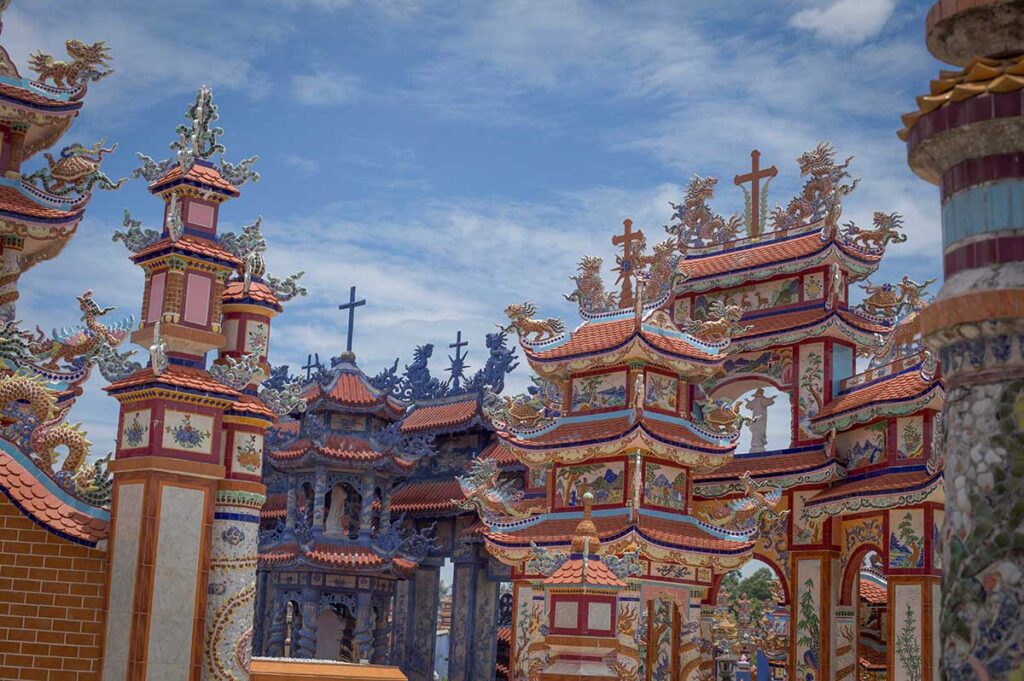
- The tombs blend Buddhist, Taoist, Catholic, Chinese, and Western elements, often on the same structure.
- Look for designs inspired by Nguyen dynasty royal tombs or even the Hue Citadel, recreated in miniature.
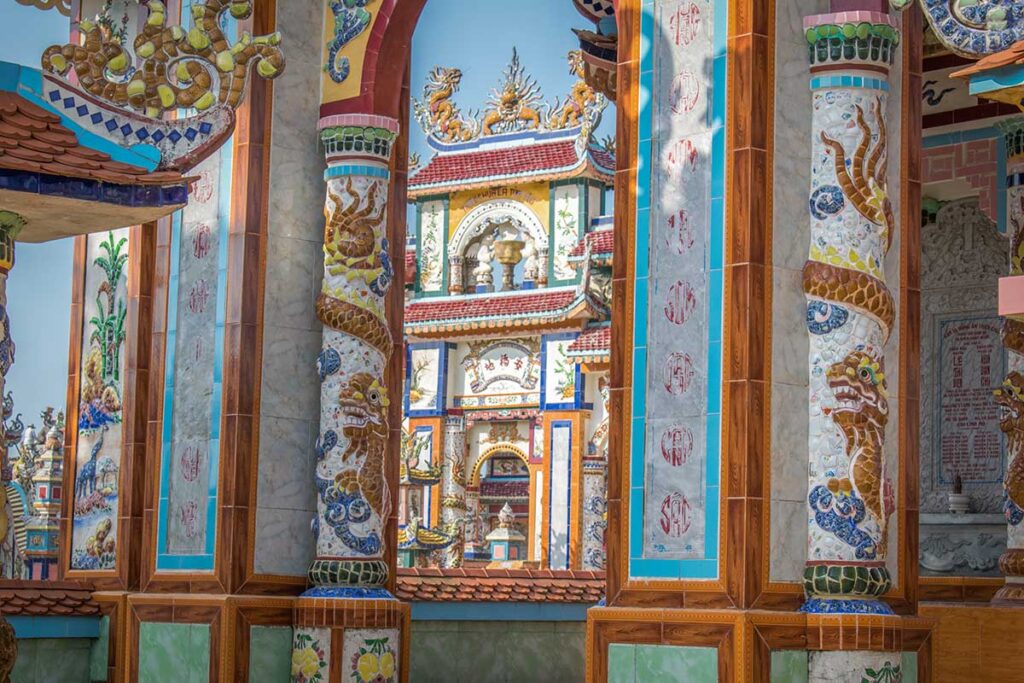
- Mosaics and glazed tiles sparkle in the sunlight, with dragons, phoenixes, lions, and other mythical guardians adorning walls and gates.
Time needed & Pacing
A quick visit can be done in about 30–60 minutes, but if you enjoy photography or cultural details, plan 1.5–2 hours. The area is large and maze-like, so mark your starting point on your phone or note a landmark — it’s surprisingly easy to lose your sense of direction among the dunes.
Entrance & Costs
There’s no ticket booth or entrance fee, and the site is open at all times. It’s best to visit in daylight hours for visibility and safety, and out of respect for the families who maintain the area.
Parking & Access
You can usually park along the village road or near the entrance lanes. Confirm with your driver or a local where it’s safe to leave your motorbike or car. Avoid blocking narrow passages used by residents or construction workers who maintain the tombs.
Navigation & Safety
On Google Maps, search for “Nghia trang An Bang.” The roads within the cemetery are sandy and uneven, so walk carefully, especially after rain when they can be slippery.
Accessibility notes
An Bang Cemetery is not suitable for travelers with mobility issues. The terrain is entirely sand, with small steps and walls scattered throughout. There are no paved paths or handrails.
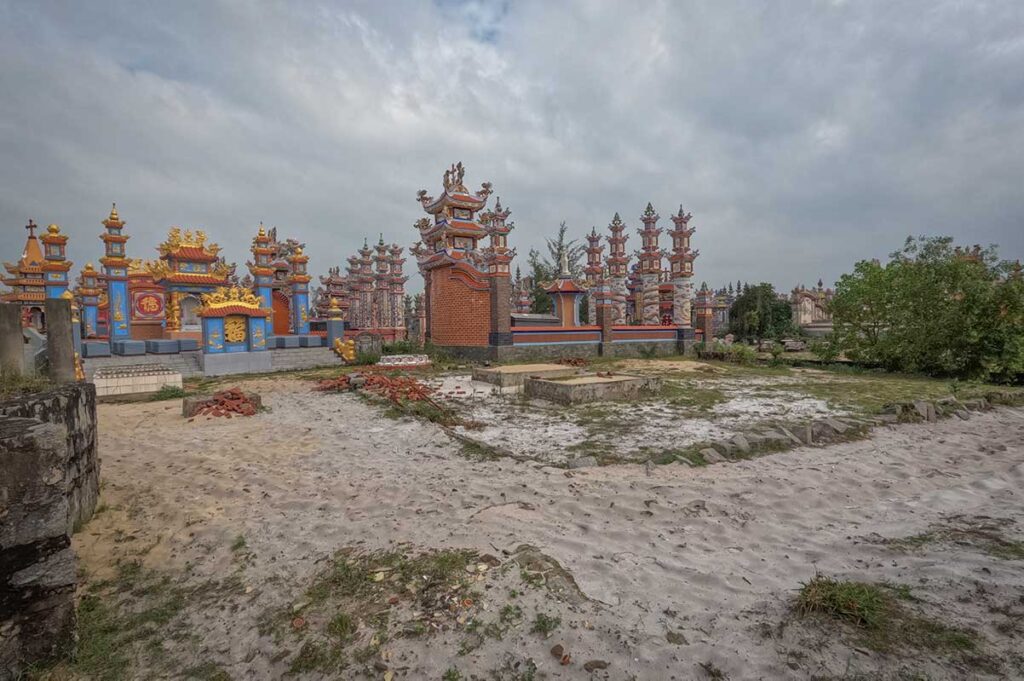
Guided vs DIY
Exploring on your own works perfectly if you just want to wander, take photos, and absorb the atmosphere. However, if you’re curious about symbolism, local families, or the stories behind the tombs, hiring a local guide or driver who knows the area adds a lot of value. They can also help navigate the small roads and ensure you don’t miss the most striking areas.
What is nearby to combine a visit?
An Bang Cemetery is quite out of the way, surrounded by dunes, fishing villages, and quiet local life rather than big attractions. If you’ve come this far, it’s worth exploring a few places nearby, though most are simple, local stops rather than headline sights.
Local beaches: Directly behind the cemetery lies An Bang Beach (the local one, not the famous Hoi An beach of the same name). It’s mainly used by fishermen and families from the village — a peaceful spot to catch sea breeze, watch fishing boats, or enjoy a casual seafood lunch. A little farther along the coast are Vinh Thanh and Phu Dien Beaches, both quiet stretches where you’ll mostly find locals walking, swimming, or mending nets.
Tam Giang (Cau Hai Lagoon area): Just inland lies part of Vietnam’s largest lagoon system, a beautiful landscape of stilted fish farms and reflective water. The section near An Bang is known as Cau Hai Lagoon, ideal for scenic drives, simple waterside eateries, and photography around sunset or sunrise.
If you’re already spending a day exploring Hue’s countryside, you can also stop by places like Thanh Toan Bridge or small rural villages for a glimpse of daily life.
Tip: Add to Hue–Hoi An/Da Nang ride
If you’re already planning to travel between Hue and Hoi An (or Da Nang) — as most travelers do — the best way to include An Bang Cemetery is to make it a stop on that scenic transfer day rather than a separate trip. The drive between Hue and Hoi An naturally follows the Hai Van Pass, one of Vietnam’s most spectacular coastal roads. Most travelers do this journey as a day tour, either by motorbike (Easy Rider style) or private car with driver, visiting highlights such as Lap An Lagoon, Lang Co Beach, and the mountain pass itself.
Since An Bang Cemetery lies near the Hue side of the route, it can easily be added at the start of the journey (or end if you are coming from Hoi An). This way, you won’t need to spend two hours driving out and back from Hue — you simply begin your day with this unique stop before continuing south toward the coast and mountains. Whether you’re driving yourself or arranging a private transfer, ask your guide or driver if they can include An Bang Cemetery in the itinerary — most are happy to do so with a little advance notice.
Is An Bang Cemetery worth to visit?
For most people who make the trip, An Bang Cemetery is absolutely worth visiting — not because it’s lively or packed with things to do, but because it’s visually and culturally unlike anywhere else in Vietnam. The scale, craftsmanship, and mix of styles make it one of the country’s most impressive pieces of folk architecture. It’s a fascinating place to walk quietly, take photos, and reflect on how deeply ancestor worship shapes Vietnamese life.
You’ll love it if you enjoy photography, culture, architecture, or off-beat places where few tourists go. The vivid mosaics, colorful tombs, and eerie silence create an atmosphere that’s both peaceful and awe-inspiring.
However, it’s not for everyone. If visiting cemeteries feels uncomfortable, or if you’re short on time and mainly focused on Hue’s imperial tombs and historical sites, you might prefer to skip it. The sandy terrain can also be tricky, so it’s not ideal for travelers with mobility issues. But for those who make the journey, An Bang often ends up being one of the most memorable and thought-provoking stops in central Vietnam.
